

Thursday, September 5, 2002
![]()
Toilet Paper Trash
Today everyone but us went out on the boat to do more manatee scans. We
stayed back at camp to write content for the web site.
web site.
Once the boat left the dock we set up in the kitchen. It was nice to be
alone for a day. We soon discovered that when everyone is away, the wharf
crabs that live in the kitchen come out from their hiding places. Apparently
they like to climb on your toes and nibble your cuticles. Caryn said that
many times in the night, when she gets up to walk around, they climb on
her toes. Working at the table this afternoon, Susan felt something nibble
her big toe. Startled, she jerked her foot and flung a crab clear across
the room. We guess Caryn was right, but we prefer the pedicures we get back
home.
Of course we were given some chores to do while everyone was out—seemingly
simple chores—like burn the trash and clean the bathrooms. At home
one merely throws trash in the trashcan, recycles what is recyclable, and
the garbage people come once a week and take it all away. Well here, there
is no recycling, there are no garbage people, and toilet paper doesn’t
go in the toilets. Everything—toilet tissue, plastic containers, paper—except
the cans, gets burned.
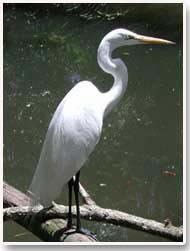 We
dutifully took all the trash and a lighter out to the pit. We waited until
the hottest part of the day to burn—our first mistake. Second, we were
totally grossed out by the week’s worth of toilet tissue and couldn’t
quite figure out how to get it out of the boxes without touching any. It
is bad enough touching your own toilet paper when you accidentally miss
the toilet at home, but this was the toilet paper from 10 people and 5 days!
Next, we couldn’t get the 10-cent lighter to burn anything except the
tips of our thumbs. It would have been easier if we’d had a magnifying
glass and used the sun to start the fire! Finally, after we got the paper
contained in the fire area, a wind came up and started blowing it around.
That was frightening!
We
dutifully took all the trash and a lighter out to the pit. We waited until
the hottest part of the day to burn—our first mistake. Second, we were
totally grossed out by the week’s worth of toilet tissue and couldn’t
quite figure out how to get it out of the boxes without touching any. It
is bad enough touching your own toilet paper when you accidentally miss
the toilet at home, but this was the toilet paper from 10 people and 5 days!
Next, we couldn’t get the 10-cent lighter to burn anything except the
tips of our thumbs. It would have been easier if we’d had a magnifying
glass and used the sun to start the fire! Finally, after we got the paper
contained in the fire area, a wind came up and started blowing it around.
That was frightening!
At long last, we caught some paper on fire and soon had a hot blaze. The
plastic containers exploded and burned bright colors. Amazingly, as the
fire burned the wharf crabs (we mistakenly identified them as fiddler crabs
last week) climbed in and out of the fire. Clearly, there is more to these
wharf crabs than meets the eye. A lizard crawled out from under a nearby
leaf and scurried to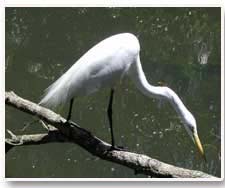 safety.
safety.
When Hannah came back, she told us that the way she burns the trash is to
put it all in a large, old box and pour gasoline on it. It then burns quickly
and without any trash blowing away. We could have used that little piece
of information before we started!
After our dreadful trash burning experience we scrubbed our hands and feet
with Pine Sol and took a swim. Sultan jumped in with us, whining the entire
time he was in the water. A beautiful Great Egret (Casmerodius Albus) or
a Gallin, as it is called locally, rested nearby. We watched as it stretched
its long slender neck, getting ready to spear a fish it saw in the water.
Egrets are as still as statues when they are fishing and they have a dead-on
aim when it comes to spearing their prey. After our swim we made some fresh
limejuice and continued working.
Dolphins
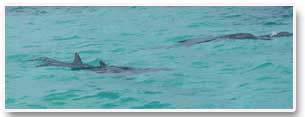 One
of the tasks today for the team on the boat was to teach Jen and Steve how
to collect data. Neither of them have snorkeled much before, so that was
a new experience for them as well.
One
of the tasks today for the team on the boat was to teach Jen and Steve how
to collect data. Neither of them have snorkeled much before, so that was
a new experience for them as well.
Traveling out to the reef the team saw a school of four dolphins. Gilroy
stopped the boat so that the team could watch the dolphins. The dolphins
swam right next to the boat.
The team did a scan at the reef but didn’t see any manatees. They took
environmental data at every single scan point. Yikes! This involves measuring
turbidity—both depth and horizontal, water temperature from both the
surface and the bottom, and salinity from both the surface and the bottom.
Everyone spent an hour or so snorkeling the reef. They spotted blue tang,
barracudas, squirrel fish, hog fish, and multicolored damsels. Terin saw
a baby Jew fish and in her words “they are big, ugly, prehistoric,
scary looking fish.” After the snorkel, the team traveled to various
narrow bogues to continue surveying for manatees.
Dead Man’s Float
At one point during the day, Kevin and Krisan were in the water and Terin
thought she spotted a manatee nearby. Caryn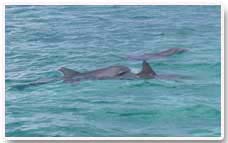 shouted, “Dead man’s float!” to Kevin and Krisan. We are
trained when we hear this to lay absolutely still face down on the surface
of the water and just float until the manatee swims away, so as not to scare
the manatee. Kevin and Krisan immediately assumed the position. Finally,
after some time, Kevin raised his head to ask if they could come up. Caryn
had forgotten about them.
shouted, “Dead man’s float!” to Kevin and Krisan. We are
trained when we hear this to lay absolutely still face down on the surface
of the water and just float until the manatee swims away, so as not to scare
the manatee. Kevin and Krisan immediately assumed the position. Finally,
after some time, Kevin raised his head to ask if they could come up. Caryn
had forgotten about them.
Reconnaissance Survey
The team did a 30-minute reconnaissance survey at the end of G1 (an arm
of Bogue G) in the afternoon. There are three channels that continue into
the mangroves, which are all too narrow for the boat, so surveys can only
be done by snorkeling up each channel. Caryn and Katie have often spotted
manatees in these channels. The team broke into groups to survey the three
300-meter channels.
The channels are narrow and lined with mangroves. They are also shallow,
from two to four feet deep, with muddy bottoms. The visibility can be very
low as the water is easily clouded by stirred up mud. They said it was somewhat
scary swimming slowly up the channel, knowing that this kind of area has
crocodiles. They could see pulsing jellyfish on the bottom that sometimes
were only a foot or so from their chests. They had to try to keep going
while looking up for branches and looking down for manatees and jellyfish
and trying to forget about the crocodiles.
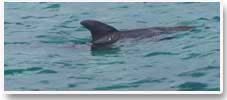 About
half way up the channel that Kevin, Caryn, Steve, and Tami were surveying,
they suddenly encountered a manatee. The juvenile manatee was relatively
small—five to six feet and seemed to appear from nowhere.
About
half way up the channel that Kevin, Caryn, Steve, and Tami were surveying,
they suddenly encountered a manatee. The juvenile manatee was relatively
small—five to six feet and seemed to appear from nowhere.
The manatee passed Caryn as she was in the lead of this group and had her
underwater camera with her. The manatee then turned in front of her as she
was filming and swam beneath her, then under Kevin, Tami, and finally Steve.
Steve however, never saw the manatee. In fact, Steve does not believe they
exist since he didn’t see any of the manatees all day.
Swimming With Jelly Fish
In the mangrove ecosystem lives a special kind of jellyfish called the Mangrove
Jellyfish. These jellyfish lay upside down on the sea bottom with their
tentacles floating up towards the surface. Zooxanthellae, or microscopic
algae, live inside the tentacles. These algae also live inside coral polyps,
giant clams, and other sea organisms. The jellyfish tentacles glow a blue-green
but it is the algae that are the source of the color.
The jellyfish are relatively harmless except when they are mating and the
females are releasing eggs. Divers must swim very slowly over them so as
not to disturb them. Caryn is always reminding us to keep our fins up when
we snorkel so as not to disturb the sea floor sediments. She said that this
was the new place she was going to take people to teach them how to snorkel
from now on. Everyone was so afraid of the jellyfish that they never put
their fins down!
Gilroy Robinson
Gilroy was born in Belize City but grew up in a small village in the Belize
District. When he was a boy, Belize was still a British colony. He remembers
the British soldiers stationed here at the time.
He, his mother, and his brothers and sister lived in a small house without
running water or electricity. They used kerosene lanterns and buckets to
collect water from the nearby river. His family farmed vegetables, rice
and corn for their own food and for selling at the local market. Gilroy
attended the village primary school, and while he started secondary school,
he never finished. He speaks English of course, but also Creole and Spanish.
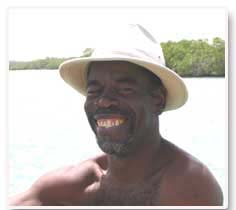 Gilroy
is a smart man. He knows so much about the local flora and fauna that he
is a great resource for Caryn and Katie. He was one of a few field assistants
that they hired their first year here. Gilroy was so interested in learning
about their research and conscientious about his work that they decided
they only wanted to work with him. He really is the “do all” person
around here. When manatees are sighted, Caryn and Katie rely on Gilroy to
verify the sighting and the actual number of manatees. He has a third eye
that the rest of us do not have! When we asked him why he likes working
for Caryn and Katie, he said that as a fisherman, he never paid much attention
to the manatees. They were just there. Now he has a greater understanding
of them and wants to help protect them.
Gilroy
is a smart man. He knows so much about the local flora and fauna that he
is a great resource for Caryn and Katie. He was one of a few field assistants
that they hired their first year here. Gilroy was so interested in learning
about their research and conscientious about his work that they decided
they only wanted to work with him. He really is the “do all” person
around here. When manatees are sighted, Caryn and Katie rely on Gilroy to
verify the sighting and the actual number of manatees. He has a third eye
that the rest of us do not have! When we asked him why he likes working
for Caryn and Katie, he said that as a fisherman, he never paid much attention
to the manatees. They were just there. Now he has a greater understanding
of them and wants to help protect them.
Aside from everything else Gilroy does as a field assistant, he also keeps
an eagle eye out for us when we are out snorkeling. Nothing misses his watchful
eye. He is always watching each one of us to see that we are doing okay.
Often times he will give the, “Are you okay signal?” with his
arm and it is always reassuring. We keep our eye on Gilroy while out in
the water, as we know if danger is nearby, he will warn us.
In the past, Gilroy worked as a manual laborer, a tour guide, a dive master,
and as a fisherman. Watching him swim in the water is like watching a fish.
He is graceful and strong.
Always cheerful, we hear he makes a mean Creole bread. This involves a special
Belizean dance called the Punta, which is done while kneading the dough.
We are still waiting for this special treat. We found the recipe in the
kitchen and included it so you can make this bread at home. You are on your
own with the Punta dance. We don't have a clue how this is done.
Gilroy’s Creole Bread – makes two loaves
7 cups of flour
2 tsp instant yeast
Gilroy’s handful of salt (about 2 tsp)
5 rounded tsp sugar
3/8 cup shortening
3/4 can coconut milk 14oz.
1/4 can water
Dance the Punta while mixing all the ingredients together.
Kneed for approximately 3 Punta songs (keep your hips moving).
Roll out into a roll and place into a well-greased pan. Place bread in warm
area to allow bread to rise for approximately 1 hour.
Cook in oven at low setting for 35-40 minutes.
Enjoy!
FYI: The boat team had four manatee sightings. Not bad for Jen and Steve's first day. However, it was such a busy day for the boat team that they forgot to take any photographs.
![]()